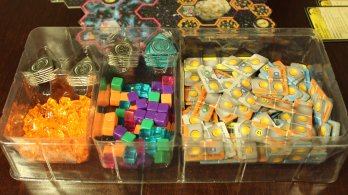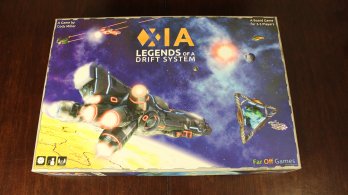
There are a few people I play games who turn their nose up at Kickstarter games. The phrase, “Well it is only a Kickstarter game,” has been spoken on more than one occasion. Some cling to this idea that a small independent company, or worse yet a single designer, could not possibly put out a game of any quality. Xia: Legends of a Drift System shatters this stereotype without even taking a moment to acknowledge the potential nay-sayers. The one man team behind Far Off Games, Cody Miller, went above and beyond all expectations when he delivered his baby to his backers a few months ago.
Before any games of Xia were even being played, Cody Miller was setting his company and game apart. The funding campaign was just about flawless. From the time Cody launched the Kickstarter all the way up through product delivery there were weekly project updates that were surprisingly informative and a joy to read. Starting with the naming of the ships, the backers were included in the process as much as they could have been. If only all Kickstarter campaigns could be as fun as the Xia campaign.
[singlepic id=20395]
Xia is self described as a sandbox game. In it, players are given a spaceship and long list of ways to get victory points and credits. If someone likes to be aggressive and attack their opponents, they can load up on guns and shoot away. If someone wants to take up the merchant trade and tool around picking up goods and delivering them, that is just as viable. The seven different ways players can get victory points are outlined more than once.
To match these scoring options, each player is given a shmorgishborg of customization options to make their ships their own. Over the course of the game players will upgrade their dinky tier one ships up to massive tier three hulks. Each tier has a collection of unique ships available, each with their own miniature and ship mat. Each ship also has a unique power that stays with the player as they upgrade their ships. This means that by the end of the game the set of three powers are always different.
[singlepic id=20399]
Each ship also has a unique hold layout that houses the equipment outfits and cargo. The outfits, which provide blaster, missile, shield and engine upgrades, fit together like Tetris pieces. This constraint means not all ships can hold the same number or type of outfits. The high level upgrades are physically larger and take up more hold space. Whatever hold space is not taken up by upgrades can be used to hold cargo, so a trading ship is not going to have much room for armaments, and trade offs between powerful shields and lots of blasters must be made.
On each turn, players have the opportunity to place up to four armed action tokens on to their outfits to utilize that specific ability. For example: if a player were to place a action marker on a mid level engine, they would roll a d8 and move that many spaces. Weapons and shields work the same using various sided dice from d6 up to d20. The action markers interact with the ship’s energy reserves. Energy is the main resource used by the ships for performing actions in the game. If you want to recharge your action tokens, you must use energy. If you want to scan the sector next to yours, you must use energy first. These energy reserves are topped off when a ship lands on a planet.
Hexagonal sector tiles make up the board. Each one is unique with a different space environment from planets to asteroid fields. The tiles are segmented into various spaces for the players to interact with and move across. The most important space is the mission points, which allow for players to pick up new missions or complete others.
[singlepic id=20390]
Along with the player’s ships, there are three NPC ships that roam around the galaxy. The merchant ship predictably cycles around a trade route, slowly accumulating credits. The Enforcer targets the closest outlaw ship and attempts to destroy it. And the Scoundrel goes out looking for innocent ships to plunder. These ships have a set script that they players move them through, and are certainly affected by what the players do on their turn.
Xia’s quality is stunning. It does not seem like any expense was spared. Every single component is of the highest quality possible. This includes custom metal coins, bright plastic cargo cubes, and most impressive twenty one unique pre-painted ship miniatures. These ships all have their own feel and look with a paint job that would only be better at the hands of a veteran minis painter. There are only a handful of games that I would even consider comparing to the quality of Xia. It certainly stands out.
[singlepic id=20392]
The rules to the game are intuitive, but can be a little cumbersome on the first play though. The rule book is very detailed, but due to the nature of the open ended game the rules are just as broad and sweeping. It took some time to get through the rule book, and even after a handful of plays, I find myself referencing it for clarification.
The game is labeled as three to four players, and works great at those numbers. We did trying playing a two player game, and were surprised to have just as much fun as a full game. The NPC ships are a must with two players though. Game length is largely decided by the victory point threshold. A five point game could be done in 45 minutes, while a full twenty five point game could take three to four hours. It has been suggested that instead of playing to a victory point number, simply play for a set amount of time and see who has the most points at the end.
It is very easy to compare Xia to other pick up and deliver games, most notably in my collection Merchant of Venus and Firefly: The Game. If you judge Xia based simply on the pick up and deliver mechanic it is not quite as refined as others in the genre. The path from point A to point B is fairly straight forward in Xia, and the goods are not volatile at all. This means that by the end of the game, profitable trade route are obvious to you, and your heavily armed opponent. This is what makes Xia amazing. If one player finds an easy way to make money or points, the other players will want in on that piece of pie and the race is on.
[singlepic id=20393]
Over the course of the game, players are encouraged to dabble in various methods of point generation. This encouragement comes in the form of the mission cards. While looking for work, players may find themselves on the wrong side of the law, and all of a sudden they are outlaws, which shifts the entire dynamic of the game. This flexibility leads to an interesting narrative as you struggle to keep up with your ever changing opponents.
Once the basics of play are understood, turns go by fairly quickly. This is significantly affected by the action marker system. As markers can only really be used in one of four different ways, player’s have plenty of time to think about what they are going to try to accomplish while their opponents are taking their turns. By the time it comes around to them, players should know what their plan is. In general, the plethora of options available to a player are managed in harmony to prevent analysis paralysis issues.
[singlepic id=20400]
Gamers who are randomness adverse are not going to like the various random elements in Xia. Like any game with randomized combat, a lucky die roll can change the course of the game. Randomness plays heavily into everything, from the combat system, the movement system and some of the missions. If your opponent gets a little lucky by rolling two good rolls on a upgraded d12 blaster, and you get very unlucky on your shield rolls (regardless of your upgrade level) you could find yourself with a very damaged ship. Paired with the dice based randomness, the location randomness can occasionally benefit one player dramatically more than the other players. This is most often seen when two planets are placed right next to each other where one offers a good that the other is selling.
One of my favorite, and most intuitive mechanics in the game is how damage is handled on the ships. When your vessel is dealt damage, you must make a choice as to where it will go in your hold. Damage markers effectively cancel out the space they are put in. If this is on a cargo cube, the cube is jettisoned. If the damage is on an outfit, that outfit suffers a -1 die roll modifier for each damage, possibly even preventing the use of the outfit altogether. The thematic feel from your crippled ship is present when it takes you two turns just to make it back to a planet for repairs.
[singlepic id=20391]
The story of Xia comes out when the players choose to call it out. It is more than possible to rush through the game and forget to notice the story as it unfolds. Xia is played best more as an activity in story generation than a competitive beat your opponent’s experience. Players who are looking for a system to optimize are going to feel let down by Xia’s scoring opportunities. There are some avenues in some games that are obviously better, and obviously overpowered. But the players who pick a play style and have fun in the space, will find endless enjoyment. Xia clearly falls into the thematic game category well before the strategy game section.
While I find Xia to be incredibly balanced for such a sprawling game, there are some divergences that can lead to a lopsided play experience. While I have not had time to fully investigate the full effects, it seems like some of the ship powers are disproportionately good. I have yet to play a game where someone has not played with the Puddle Jumper whose power is to regain energy in open space. This power is used every turn, and to great effect. In the same games, I have seen some players never use their power because it was never beneficial. Personally I would rather have great variation than perfect balance, but I can see how some would find fault in this.
Xia: Legends of a Drift System
Designed by: Cody Miller
Published by: Far Off Games
Players: 3-5 (two players works fine)
Time: 120 minutes
Age: 12+
Weight: Medium
Mechanisms: Sandbox, Exploration, Pick up and deliver, Dice based combat, Action point selection
MSRP: $89.99
Xia: Legends of a Drift System
Excellent
Xia: Legends of a Drift System has joined a select few games that have come out of the Kickstarter world and proven that traditional publishing is not the only way to produce a high quality, enjoyable game. I highly recommend this game to people who are looking for an inviting and immersive experience. Players who like to explore different areas of a game are going to have a great time playing around with the game system. I can see how Xia would not be the best choice for all gamers, but it has become one of my favorites of the last year. As Cody says, see you starside.
Pros
- solid mechanics
- supports diverse play styles
- highly thematic
- flawless execution
Cons
- possible balance issues
- high degree of randomness
- possible obvious play situations










